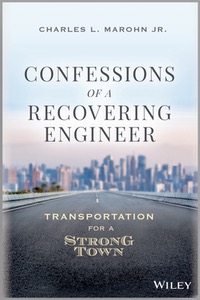In October 2019, Wiley published ‘Strong Towns: A Bottom-Up Revolution to Rebuild American Prosperity’, the first book by Strong Towns founder and president Chuck Marohn. Since its release, we’ve heard of many local conversations and small groups around North America who have gone through the book together. Community advocates are using it to seed the Strong Towns conversation in their places, or nurture one that’s already begun.
Recently, Chuck sat down and responded to several questions sent to him by one of those book clubs. We are sharing his responses in two parts. (The articles first appeared on the StrongTowns.org website.)
When you started to write Strong Towns, who was your intended audience? Has your intended audience changed since writing the book?
Assuming you are talking about the site Strong Towns (not the book), back in 2008 my target audience was fellow professionals and perhaps some public officials. I thought if I could just help them see what was going on, they would change their approach. That was wrong.
Over time, I came to realize that most of our audience is what we call “concerned citizens”—not public officials or city-building professionals. That’s really amazing, actually (at least to me), and it reinforces three insights, in my opinion. (1) People really care about the future of their places, and (2) many people are not satisfied with the current approach, and (3) a lot of people are ready to step up and do something about it.
members.jpg
For what it’s worth, I have always written with my Dad in mind. I’m always writing in a way that he can understand and in a way that — hopefully — convinces him, which was always my challenge growing up. If I can move my Dad’s thinking, I can move anyone’s thinking.
Do you plan on writing a follow up to Strong Towns?
 Not just plan! I finished the book over the holidays. Wiley & Sons will publish Confessions of a Recovering Engineer: Transportation for a Strong Town sometime around September 1, 2021.
Not just plan! I finished the book over the holidays. Wiley & Sons will publish Confessions of a Recovering Engineer: Transportation for a Strong Town sometime around September 1, 2021.
Strong Towns: A Bottom-Up Revolution to Rebuild American Prosperity was the first in a five-part series I pitched to the publisher. The entire series will be:
- Strong Towns (finance and core insights)
- Confessions of a Recovering Engineer (transportation)
- Unnamed housing book
- Unnamed economic development book
- Unnamed urban design book
Then I’m done and will go do something else with the rest of my life.
What do you consider to be the weakest arguments in favor of the “Strong Towns” movement? What do you consider to be the strongest arguments against it?
There are a lot of bike/walk advocates, urban design advocates, and transit advocates who love our work but only as far as it bolsters their niche passions. I’ll take it — you don’t have to swear allegiance to be part of our conversation — but they are uneasy allies because they often don’t care as much about the core financial solvency argument. We look at their passion issues as a means to an end (that end being financial solvency and community stability) while they look at them as an end unto themselves. We can be allies and hopefully inform each other’s worldview.

In terms of strong arguments against, there are two common ones that are weak and then one really good one that is never made, mostly because you have to grasp the insolvency stuff first, and that’s a hard intellectual leap for true critics.
The first counter argument is that the world is a dumpster fire and we need to take aggressive action now to address all these critical problems. We don’t have time to work incrementally and money is just an abstraction so who really cares about balancing the budget. I find this to be the ultimate combination of ignorance and hubris, and I refute the argument directly in Chapter 6 of Strong Towns:
Once we accept the cities are complex systems, we are forced to come to grips with the reality that we can never fully understand them. More to the point, what we often think of as simple and obvious solutions to the problems we face are simple and obvious only because of our limited understanding. The more we truly know, the less clear things become.
The second comes from the so-called Market Urbanism community, a group of libertarian-leaning urbanists who have—in my opinion—a limited understanding of how markets work at the very local level. I responded to one of them with a seven+ part series about free markets and Strong Towns. My summary: you can’t just call every outcome you like “the market” and every outcome you don’t like “government intervention” and believe you’re doing something intellectually rigorous. That and they need to learn to read a balance sheet.
The best argument is never made—at least I’ve never heard it—and so I addressed it in Chapter 2 in the section called “The Stifling Nature of High Land Values.” I can summarize it by saying that a Strong Towns approach is designed to create stability, but a side effect of stability is that, especially during times of low or no growth, there can be a stifling stagnation of wealth that robs a community of its dynamism. The rich will stay rich because they own everything and the poor will stay poor because they don’t have enough opportunity to start with nothing and build something. This is stable and the community will survive, but not necessarily with broad prosperity (although it could be, depending on the disposition of the community).
I actually think this third argument is a big underlying reason why so many Americans were willing to throw away existing cities and neighborhoods and try something new after World War II. It is a little like flipping over the chess board and starting the game over again, a very progressive instinct but one that often ends in evolutionary dead ends…

